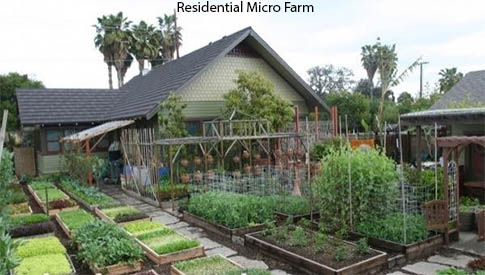
WEDNESDAY, APRIL 8, 2015

Community Micro-Farms
How to occupy the farm
Eric Lee, A-SOCIATED PRESS
TOPICS: RAINWATER HARVESTING, FROM THE WIRES, GREEN LIVING, REALITY-BASED, SURVIVAL ISSUES
Abstract: Urban micro-farming is increasing and became a necessity in Cuba after the loss of continued economic support from the USSR. Urban farming may become a necessity elsewhere and elsewhen. Why wait? Seek out the condition now that will come anyway.
TUCSON (A-P) — Urban micro-farms differ from community gardens. Farms also grow plants, but what is the farm without farm animals, a farmhouse, farm pond, and farmers? In residential areas (excluding HOAs) the farm would be a family farm whose farmers would live in their farmhouse continuously. Permitted farm animals would be limited to chickens (hens), ducks, fish aquaculture, bees, worms, rabbits, guinea pigs, and other small stock. Excluded would be goats and pigs. On commercial (C2) zoned property goats and pigs may be permitted by city zoning (e.g. Tucson). Community micro-farms would occupy commercial, church, or public property by permission of the owner.
 Even if city water were free, it is unsuitable for agriculture in the long run of things. Dissolved salts are left behind. Groundwater can be used for a limited time, for decades, perhaps centuries, but eventually salts build up in the soil, especially in low rainfall areas, and ruin it. To avoid this, to actually farm sustainably, you could desalinate the irrigation water if energy was too cheap to meter (it isn't and don't count on it ever being), or catch the distilled water that falls as rain. Rain that falls on a roof is not harvested unless it is stored.
Even if city water were free, it is unsuitable for agriculture in the long run of things. Dissolved salts are left behind. Groundwater can be used for a limited time, for decades, perhaps centuries, but eventually salts build up in the soil, especially in low rainfall areas, and ruin it. To avoid this, to actually farm sustainably, you could desalinate the irrigation water if energy was too cheap to meter (it isn't and don't count on it ever being), or catch the distilled water that falls as rain. Rain that falls on a roof is not harvested unless it is stored.
"Harvesting" rain that falls on the ground by diverting it to planted areas is not actually being harvested for use when needed. Much or most will evaporate or percolate below the root zone, even if none flows away. At best, rainwater "harvesting" by diversion makes use of about half the rainwater, but provides needed water for a crop for a time only after a rain. In Tucson there may be no rain April thru June when perennials need water and it is warm enough to plant and grow. Winter rains have to be harvested from roofs and stored. Diverting rainwater is useful but to irrigate between rains, water has to be collected and stored.
Surface flow could be diverted to a below ground pond or tank, but then energy would be needed to pump it to irrigate with. Rainwater that falls on a roof can be gravity piped to an above ground pond from which water can be drained for irrigation without any energy inputs other than turning a valve. Digging a below ground pond and lining with pond liner involves a lot of digging and forces water to be pumped forever. If all irrigation water had to be pumped by humans using a hand pump it would soon be evident why this was not the better idea. An above ground farm pond requires a bit more materials than a pond liner, but is easier to build, can be moved or removed, and no pumping required. The top of the pond merely needs to be below the roof's gutter downspouts. The potential energy of rain on roofs should also be harvested as a valuable energy resource.
Alternative to a farm pond would be a closed tank, but on a farm the only need for a tank is to hold pond water that has been filtered for drinking. A farm pond is for aquaculture and irrigation. Floating pads could produce duckweed or even sprout fodder that fish could not get to. Mosquito fish will control mosquitoes. Duckweed and azolla could feed chickens, ducks, or tilapia while grain could be sprouted to feed small stock.
 Community farms would need a farmhouse for the farmers—not to live in but to hang out in. It would include an outdoor community kitchen with solar cookers. The "farmhouse" structures could be modular and temporary. Any roof area, for shade and solar collection, would also collect rainfall. Community farms would be fenced as good fences not only make good neighbors but protect small stock and crops from neighborhood dogs and other marauders. Internal fencing would protect crops from free-ranging livestock. Access would be by combination lock, changed as needed, and only farmers would be given the combination. First one there in the morning would leave the gate unlocked and hang out the welcome sign as visitors would be encouraged to tour the farm. The farmhouse would invite visitors and community members to hang out and bond with crops and farm animals. Children would be at risk of being educated.
Community farms would need a farmhouse for the farmers—not to live in but to hang out in. It would include an outdoor community kitchen with solar cookers. The "farmhouse" structures could be modular and temporary. Any roof area, for shade and solar collection, would also collect rainfall. Community farms would be fenced as good fences not only make good neighbors but protect small stock and crops from neighborhood dogs and other marauders. Internal fencing would protect crops from free-ranging livestock. Access would be by combination lock, changed as needed, and only farmers would be given the combination. First one there in the morning would leave the gate unlocked and hang out the welcome sign as visitors would be encouraged to tour the farm. The farmhouse would invite visitors and community members to hang out and bond with crops and farm animals. Children would be at risk of being educated.
There are many businesses with areas of unused land that could be fenced and turned into a community farm. They also have a critical resource: rainwater from roof areas that they probably make no use of. Giving the rainwater to the community farm, perhaps named after the business, would cost them nothing. The water, however, is of great value and the business's contribution should be recognized. A tax credit would be appropriate as a water/land use donation to the non-profit League of Community Micro-Farms. At the very least, the business would receive community recognition and appreciation for gifting water and land they were not using. This is a win/win opportunity.
A pilot project would be needed and then would need to be duplicated. The nation-wide, world-wide potential could be almost unimaginably vast. Two-thirds of humanity will be living in cities by 2050. Community members willing to make a community micro-farm work by doing needed work, when not hanging out, would be the limiting factor as lots of potential rainwater and farmable areas exist. A fund to establish new micro-farms, to fund the rainwater catchment system, fencing, and farmhouse (made by the farmers) would be needed. Also needed, initially the critical need, is the vision and organization to make it happen.
If there is ever a serious economic downturn (e.g. a depression), urban residential and community micro-farms and farming will be essential. Also essential would be to have functioning micro-farms in place so a sudden demand for more could be met.

